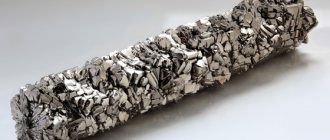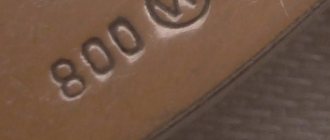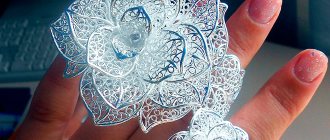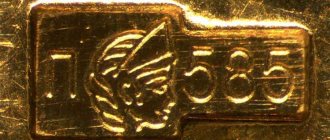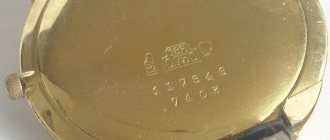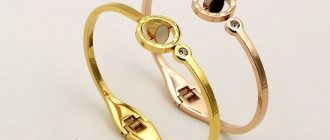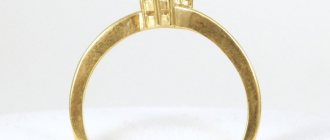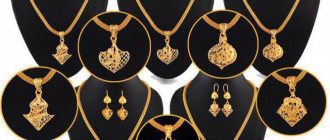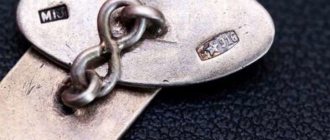An alloy of light-colored metals, which is now universally known under the name cupronickel, appeared in ancient times. In Mesopotamia, around the third century BC, it was called white copper and was widely used in the production of utensils, various vessels and household items. Then, in numerous wars and under the influence of time, the secret of alloy technology was lost for several thousand years.
It is believed that cupronickel was invented, or rather recreated, by the French inventors Maillot and Chaurier in the nineteenth century. Despite the fact that the invention was made by the French, cupronickel silver was called “German silver” for a long time. Kitchen utensils, dishes, church vessels, and decorations were made from it.
Melchior - what is it?
It is an alloy of copper and nickel. It belongs to the group of non-ferrous metals. May have minor amounts of iron, silver, cobalt, manganese, zinc and other components. The higher the percentage of nickel, the more the anti-corrosion properties of the alloy increase, and its strength and durability improve.
Cutlery and dishes made of cupronickel:
- They heat up at a lower rate than products made from other metals;
- The alloy is not subject to corrosion, does not oxidize, objects made from it do not rust;
- The material has a good degree of strength, the dishes do not deform, the cutlery does not bend during use;
- Tableware and cutlery are distinguished by their sophistication and beauty;
- Due to its composition, cupronickel has a beneficial effect on the human body;
- The items are relatively inexpensive.
The main color can vary from light tones, with a slight yellowness, to orange.
What does the marking mean?
Typically, the pure composition (999 fineness) of a noble metal (be it gold, silver) is not suitable for the production of a high-quality jewelry product. The objects obtained this way are too fragile. In order to impart improved mechanical properties and create a more saturated shiny color texture, the composition is enriched by adding parts of non-ferrous metals - this is how alloys are obtained. Marking on a product made of precious metal (including silver) shows the content of precious metal in the alloy and serves to determine its fineness.&
Samples of precious metal alloys for jewelry and other silver items, including cutlery, are established by the legislation of the country. The earliest such standard is the “sterling silver” standard (925) - this is the material for the best silver devices: durable and safest for health (since only copper is added to the composition of 999 silver).
Composition and main characteristics
Cupronickel is an alloy whose composition is 70–80% copper and 30–20% nickel. Contains no more than 1% iron and manganese, 5% cobalt.
It is much stronger than silver and lighter in weight. No magnetic properties. The higher the percentage of manganese and iron in the composition, the greater the ductility, density and thermal conductivity it has. Reacts with other metals, quickly oxidizes under the influence of water and air, so cannot be used in the dishwasher.
There are several types of compositions, which are called cupronickel. The name and technical characteristics depend on the percentage of nickel in the finished material and the presence of other components:
- Nickel silver is an alloy consisting of about 40% copper, up to 15 nickel and up to 45 zinc. Often other metals are added to its basic composition, sometimes it has a bluish or bluish tint. The composition is very durable, strong, elastic.
- Monel is an alloy with a predominance of nickel, it contains up to 67%, copper up to 35%, iron and manganese no more than 2.5%.
- Brass is a material containing up to 80% copper, up to 50% zinc, with nickel, iron, and tin. Previously, this composition belonged to the cupronickel group, so objects made of silver-plated brass were also called cupronickel.
How to determine the authenticity of cupronickel at home?
It is very difficult for an inexperienced person to distinguish the alloy. There are tests that can determine the alloy:
- Silver-plated or gold-plated devices are marked - MN, MNTs (copper, nickel, zinc). Precious metal items only have a digital hallmark.
- Drop clean water onto the item being tested. After 2-3 hours, the silver will remain unchanged, and a green coating will form on the cupronickel.
- Silver is heavier than cupronickel, so items of equal size will have different weights.
- Having rubbed cupronickel, you can smell copper, silver does not smell of anything.
- If there is no mark on the product, most likely it is cupronickel, even coated with valuable metal.
What does the mark on the KHI cup holder mean?
“Kazakovskaya filigree” deserves special attention. The mark on the KHI glass holder honored the elegant, highly artistic products of the Kazakovsky Art Products Factory. In Rus', this was the first artel where filigree items were produced.
It is quite difficult to collect many other marks that were placed not only on glass holders, but also on other products reflecting folk art, customs and traditions of the Soviet people in a single catalogue. But nevertheless, this was done in the book “Gold and Silver Business of the 15-20th Century.” The author of the book was M. M. Postnikova-Loseva, who painstakingly, bit by bit, collected historical information. The book contains images, transcripts, and each stamp has a serial number.
How to make cupronickel dark?
Darkening nickel silver, nickel silver, brass, and other alloys containing copper makes objects more attractive. Under normal conditions, the process can last for years, but with the help of chemical solutions, artificial aging can be achieved instantly.
Before patination, you need to check safety precautions, since some chemical solutions are extremely toxic and emit fumes that are harmful to health. It is necessary to provide exhaust and fresh air supply.
The products must first be cleaned, degreased and washed with warm water, and dried thoroughly.
There are several ways to darken alloys:
- Using “sulfur liver” - mix powdered sulfur with potash 1:2, then put the composition in an unnecessary tin on the stove and after melting begins, heat for another 15 minutes. Cool, grind into powder, store in a sealed container. To darken the object, immerse it in a solution of 1 liter of water and a mixture - from 1 to 20 g. The more powder, the darker the product will become.
- Nickel silver alloys can be darkened with copper sulfate dissolved in water, into which ammonia is poured until a rich blue color is obtained. The object is immersed for some time in the resulting liquid and then slightly heated.
- You can treat the item with a solution of platinum chloride or immerse the item in it. If the darkening is insignificant, then pour a little hydrochloric acid into the solution.
Brand
Each product made of precious metal is marked, which consists of:
- state hallmark;
- manufacturer's mark;
- label.
State stamp
The state stamp is a sample that is set by the state assay inspection inspection and can be applied to the product in the following ways:
- mechanical (impression);
- modern (laser or electric spark method).
The brand changed its appearance:
- in 1958 they began to depict the hammer and sickle against the background of a star;
- since 1994 - in the form of a profile of a woman’s head wearing a kokoshnik.
The shape remained the same - a circle and an oblong barrel.
Manufacturer's mark
The manufacturer's mark - the name plate - is placed on all precious items and must be enclosed in a single outline. Has four capital letters which represent three characters, namely:
- year code (A-2001; B-2002 and so on);
- code of the territorial location of the Assay Supervision Inspection Department (for example, L-St. Petersburg, North-Western Inspectorate);
- department code.
Hallmark on nickel silver and cupronickel: what are the differences?
Often buyers want to purchase elegant and high-quality products known since the times of the USSR. But many do not suspect that genuine cupronickel dishes and cutlery have stopped being made since the collapse of the Soviet Union, in the middle of the last century. No less beautiful and durable objects began to be made from nickel silver alloy. It is also called cupronickel, but it contains zinc.
Nickel silver devices are almost impossible to distinguish from silver in appearance. Only that upon contact with human skin or air, silver oxidizes and acquires a dark color, but nickel silver products remain unchanged.
To distinguish cupronickel from nickel silver, you need to look at the mark - cupronickel has the sign MN (copper, nickel), nickel silver is marked with the letters MNTs (copper, nickel, zinc). If there is no mark on the item, then you need to find out the approximate date of manufacture or carefully consider the color of the item. Unlike nickel silver, cupronickel will have a yellowish tint.
What does the MNC stamp on the cup holder mean?
The MNC mark on the glass holder indicated that cupronickel does not contain lead and the material is safe for health. At the same time, the old “MELCH” mark could be placed on silver-plated glass holders. Silver products were hallmarked.
Aluminum cup holders became widespread in the 60s. They were 2-3 times cheaper and were mainly used in the railway sector. Aluminum products were not branded with a material designation, but had a manufacturer's mark.
The famous “Glukhar” of the Kolchuginsky Metallurgical Plant was one of the most recognizable brands of that time. No less popular were glass holders made in jewelry workshops bearing the “YUM” mark. The letters were followed by numbers that could be used to determine the year of manufacture. For example, the YUM0MET mark meant that the cup holder was produced in 1960 and was made of metal, i.e. steel. If after the abbreviation there was a number other than zero, then this meant that the product was produced in the 50s, and the number itself corresponded to the last one in the date of the year of manufacture.
Application area
One of the important distinctive properties of cupronickel is its immunity to sea water. Therefore, the alloy is widely used in shipbuilding, making parts for marine transport and submarines. They also make thermoelements and high-precision resistors. Cupronickel is used for modern coins. Monel alloy is used as a structural material in industry.
Widely used in jewelry. The finished products look like silver. Often blackened, patinated, processed with filigree and granulation.
For several centuries, this alloy has been used to make dishes that are not inferior in beauty to silver and superior in properties:
Cupronickel cutlery - knives, forks, spoons, made in the same design, are a table decoration and an excellent purchase for your own use and as a wonderful gift for any memorable date.
Samovars, coffee Turks and cezves are coated with a tin layer on the inside, which makes them safe when exposed to high heat.
Cup holders - low thermal conductivity and durability will allow you to enjoy your favorite drink without the risk of burning your hands.
Trays, candy bowls, dishes, salt shakers and vases - beautiful products will be the highlight of the festive table and decorate the room.
Tea and coffee sets - make up various sets and items, decorated in design, for any number of people.
Wine sets - usually a set includes a jug with glasses, a tray, and sometimes a set of saucers or shot glasses.
Varieties of cupronickel spoons:
- Traditional cupronickel spoons with blackening. Holiday option. Exquisite, each item is engraved by hand. All products have a carved monogram.
- With a polished surface - for everyday use. A monogram is usually engraved on the left side of the handle, and the alloy grade is indicated on the back.
- With natural gilding - for the most special occasions. The best and most expensive products are considered to be “Kolchuginsky Melchior”. The factory's cutlery is famous for its quality. Items with silver and gilding are designed in the style of the name of the cutlery.
Is cupronickel harmful to health?
Alloys are not only not harmful, but even beneficial to health. After all, cupronickel contains:
- Nickel – as it accumulates in the body, contributes to the long-term maintenance of low blood glucose levels and enhances the beneficial effect of the hormone insulin. Nickel ions promote better absorption of vitamin C and stabilize blood pressure.
- Copper is one of the components of human blood; it is part of enzymes and destroys pathogenic bacteria.
- Cupronickel alloy has a beneficial effect on the skin. Increases elasticity and maintains youth. With constant use of water saturated with cupronickel ions, it reduces the number of wrinkles.
